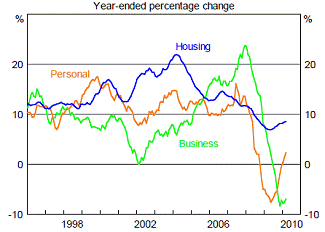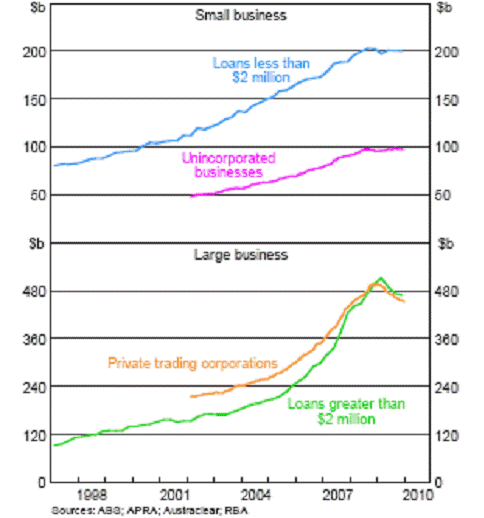Chapter 2
Recent trends in small business finance
The role of small business in the economy
2.1
The small business sector makes a significant contribution to economic
growth, accounting for 39 per cent of total value added by industry in 2007-08,
and accounting for about half of employment.[1]
2.2
Treasury attested to the importance of small business having adequate
access to finance:
Access to finance is important in allowing small businesses
to maintain their important contribution to the economy and in allowing them to
grow. The availability of reasonably placed credit allows small businesses to
expand their activities, fund new and innovative investments, smooth cash flows
and maintain employment.[2]
The extent of the lending slowdown
2.3
The Reserve Bank publishes monthly data on credit provided by financial
intermediaries, split between business, housing and other personal lending
(Chart 2.1). Business credit was expanding at annual rates of around 20 per
cent before the crisis, but has contracted since 2009.
Chart 2.1: Credit
by sector

Source: Reserve Bank of Australia (www.rba.gov.au)
2.4
These commonly-cited data do not distinguish between credit provided to
large companies and small businesses. APRA collects quarterly data from banks
on lending to business classified by the size of the loan, which is likely to
be a reasonable proxy for the size of the borrower. It shows that the cutbacks
in outstanding credit have occurred in the larger loans rather than smaller
loans (Chart 2.2).[3]
Chart 2.2: Bank
lending to small and large businesses

Source: Reserve Bank of Australia, Submission 2, p. 2.
2.5
There are signs of recovery in lending to small businesses:
... [major] banks have generally increased their lending to
smaller unincorporated businesses over the past year.[4]
Small business loans by industry and sector
2.6
The outstanding value of smaller loans (under $500,000) has fallen in
the agricultural, manufacturing and financial sectors (Table 2.1)
Table 2.1: Bank loans
outstanding under $500,000 at end-year
|
($ billion)
|
2007
|
2008
|
2009
|
|
Agriculture
|
16.1
|
16.0
|
15.4
|
|
Mining
|
0.9
|
1.1
|
1.1
|
|
Manufacturing
|
6.1
|
6.3
|
6.0
|
|
Construction
|
7.3
|
7.8
|
8.7
|
|
Wholesale & retail trade, transport & storage
|
20.8
|
22.7
|
21.1
|
|
Finance and insurance
|
3.8
|
5.6
|
4.2
|
|
Other
|
39.2
|
38.4
|
41.2
|
|
Total
|
94.1
|
98.0
|
97.8
|
Source: Secretariat based on
APRA data reported in www.rba.gov.au, table D7.
2.7
Looking at new lending by purpose, the slowdown in credit provision to small
business borrowers appears to be concentrated in loans for the purchase of real
property (Table 2.2).
Table 2.2: Banks'
new fixed business loan approvals under $500,000
|
($ billion)
|
2007
|
2008
|
2009
|
|
Construction
|
1.3
|
2.0
|
1.8
|
|
Purchase of real property
|
4.5
|
4.3
|
3.2
|
|
Wholesale finance
|
0.1
|
0.3
|
0.6
|
|
Purchase of plant & equipment
|
3.3
|
3.3
|
4.8
|
|
Refinancing
|
2.1
|
1.8
|
1.9
|
|
Other
|
9.5
|
8.8
|
9.5
|
Source: Secretariat based on APRA data reported on www.rba.gov.au,
table D7.
2.8
The banks referred to commercial property as a particularly weak sector:
...banks are very wary of lending to commercial property
because commercial property prices have fallen, as they always do during an
economic downturn. I think the banks are also remembering the early 90s when
they got into quite a bit of trouble with being over exposed to commercial
property during the recession then.[5]
2.9
Another area where lending has contracted has been in finance for
international trade:
The problem was even more dramatic for those small businesses
that were seeking trade finance—those small businesses that were seeking to
maintain some degree of export activity. Competition and other providers in
that market dried up dramatically... the banks were in the very comfortable
position of openly saying that they did not see themselves as needing to come
to the table in this market, irrespective of the level of business information
about the export activities that the SME was going to provide... They saw market
conditions overseas as vulnerable, fluky and fluctuating.[6]
Navigation: Previous Page | Contents | Next Page